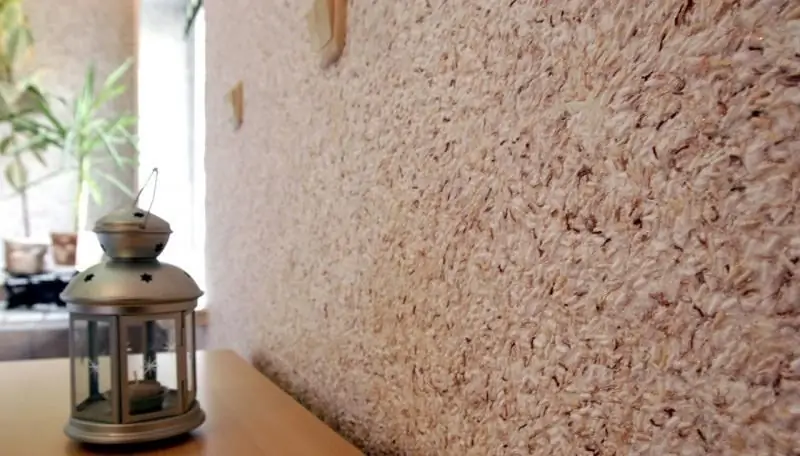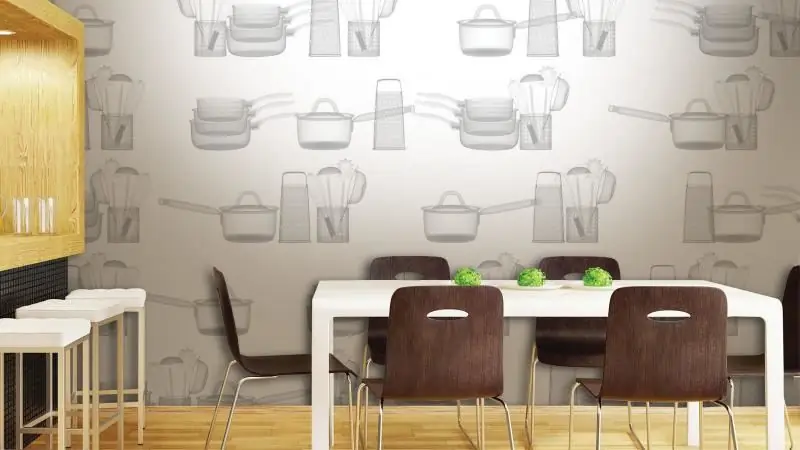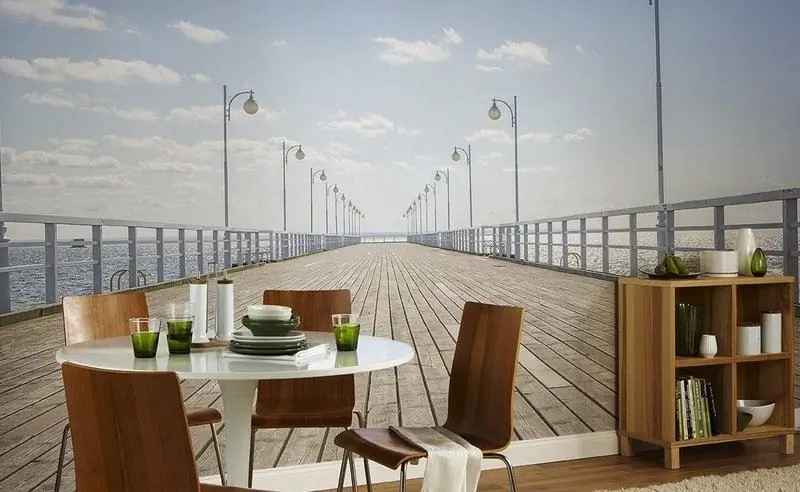
Table of contents:
- Author Bailey Albertson [email protected].
- Public 2024-01-17 22:26.
- Last modified 2025-01-23 12:41.
How to use liquid wallpaper and decorate walls in the kitchen

Liquid wallpaper is one of the modern and convenient materials that solve the problems of decoration and decoration. This structure is suitable for the walls of the kitchen, but before using it is important to know the features of the use of liquid wallpaper. Thanks to this, the design of the room will not only be harmonious, but also practical.
Content
-
1 Characteristics of liquid wallpaper
- 1.1 Pros and cons of liquid wallpaper for kitchen walls
- 1.2 Types of coverage
-
2 How to choose liquid wallpaper for the kitchen
2.1 Video: the choice and features of the application of liquid wallpaper
-
3 Materials and technology for the use of liquid wallpaper
-
3.1 Decorating the kitchen with liquid wallpaper
1 Photo Gallery: Kitchen Design with Liquid Wallpaper
-
- 4 How to care for the coating
- 5 Reviews about liquid wallpaper in the interior
Characteristics of liquid wallpaper
Many people confuse liquid wallpaper with decorative plaster and classic wallpaper, but it is worth considering that they are not applied to the wall in the form of a canvas and do not have sand, gypsum, or lime in their composition. The liquid version of the wallpaper is a mixture of silk, cellulose or cotton fibers, and glue acts as a binder. The mixture is produced in dry form, and before use it is diluted with water.

Liquid wallpaper is suitable for finishing any premises
The effectiveness of the liquid composition is due to its properties:
- high vapor permeability, providing a normal microclimate in the room;
- possibility of application on uneven surfaces (arches, rounded bases, hard-to-reach corners, etc.) due to the elastic structure;
- lack of joints and seams, uniformity of application;
- simple restoration of damaged areas by spot application of a new composition;
- additional sound and heat insulation.

Liquid wallpaper is easy to apply to walls and ceilings
Pros and cons of liquid wallpaper for kitchen walls
Compared to many other finishes, such as classic wallpaper, the liquid formulation has the following advantages:
- the ability to paint in any colors with different dyes intended for interior work;
- when wet, the coating does not change its appearance after drying;
- easy application with a spatula on a clean surface;
- affordable price and simple technology for preparing the mixture yourself.
Disadvantages of coverage:
- does not withstand strong mechanical stress and high humidity;
- can only be cleaned dry with a vacuum cleaner or brush;
- quickly absorbs grease and other difficult stains;
- does not fit well on smooth surfaces;
- burns out in the sun.
Coating types
There are several types of liquid wallpaper, differing in composition and appearance. One of them is silk wallpaper, which includes natural silk fibers, glitter and mother-of-pearl, binders, and coloring components. Such a mixture is simply diluted with water according to the instructions and applied to the prepared surface.

Silk finish suitable for wall decor in dining area
The cotton version of the wallpaper includes soft cotton fibers, glue, colored substances, a small amount of mineral elements and other components. The dried composition has a matte and slightly uneven surface.

Liquid wallpaper with cotton fibers does not absorb odor and is easily stained
The cellulosic type of wallpaper contains wood fibers. The complex is supplemented by glue, dyes and other substances. This option is one of the simpler types of finishing mix and is often complemented by silk or other types of liquid wallpaper.

Cellulose wallpaper can be supplemented with silk or other fibers
How to choose liquid wallpaper for the kitchen
Finishing material for the kitchen should not only be beautiful, but also easy to install and maintain. To do this, you should pay attention to the following selection criteria:
- the presence or absence of pearlescent elements or sparkles in the composition;
- compatibility with dyes that should be chosen after purchasing wallpaper;
- ready-made liquid mixture or dry composition that needs preparation before application;
- the volume of the composition, taking into account its application in a layer 2-3 mm thick.
Video: the choice and features of the application of liquid wallpaper
Materials and technology for the use of liquid wallpaper
You can apply liquid wallpaper yourself. This will require the following tools and materials:
- container for the preparation of the composition;
- roller, trowel, spatulas of different sizes for applying the mixture;
- rags to remove excess;
- water, soil composition for liquid wallpaper.

Depending on the treatment area, you need to select the size of rollers and spatulas
The surface for applying liquid wallpaper should not have cracks and depressions, dirty and wet spots, traces of mold and old finishing materials (wallpaper, paint, etc.). All these defects must be removed before finishing. To do this, you need to use a gypsum-based putty, antifungal impregnation for interior work.
Wall decoration with liquid wallpaper involves the following stages:
-
Apply 1-2 coats of wall primer to an even and clean wall surface. This can be done with a roller or wide brush. Each layer is applied after the previous one has dried. The primer is available in liquid form in containers of different sizes, which must be shaken before use. If the wall has an uneven color, for example, there are dark spots of plaster and light putty, then the tone of the wall should be leveled with ordinary water-based paint, applying it in 1 layer. Otherwise, stains will be visible under the thin wallpaper.

Priming the walls before finishing with liquid wallpaper Transparent primer is invisible under any wallpaper
-
For the preparation of liquid wallpaper, it is convenient to use a bucket with a volume of 10-12 liters. The amount of water is determined according to the instructions and directions on the package with the dry mix. The whole package should be kneaded at once. It is best to start preparing the composition 6-12 hours before application, since many liquid wallpapers take time to swell. In this case, you should first pour water into the container, and then gradually pour the mixture, stirring thoroughly. Glitter should be added to the water, distributing them well, and not into the finished wallpaper mixture.

Kneading liquid wallpaper for finishing It is best to mix the composition with a construction mixer and a drill, but you can also manually
-
For application, use a clear, clean trowel. A little of the mixture is applied with a spatula to the plane of the trowel, the tool is applied to the wall and rubbed in a circular motion starting from the corner of the room. After the portion of the composition has ended, more mixtures are added and work continues. When applying, it is important to consider and respect the layer thickness, which is often around 3 mm. You can spread the mixture with a roller, but it should be hard, foam rubber or with short bristles.

Applying liquid wallpaper with a trowel The trowel allows you to distribute the liquid wallpaper evenly on the wall
-
It is best to work the entire wall at a time. Otherwise, the joints will be noticeable. To avoid this, the dried edge of the finish is well moistened with water before proceeding. To work the corners of the kitchen, you can use a special corner trowel or use a regular flat tool. Drying of the wallpaper takes at least 48 hours. You can speed up the process by heating the room or simply opening a window.

Dried liquid wallpaper on the kitchen wall After the liquid wallpaper dries, you can mount lamps and decorate the room
Decorating the kitchen with liquid wallpaper
A full finish with liquid wallpaper is not always appropriate in the kitchen. For example, in a small room where dinners and high humidity are often cooked, it is best to paint the walls with a non-marking acrylic compound, and use liquid wallpaper for decoration. Such a solution will allow not only to create a unique interior, but also to avoid the accumulation of greasy stains on the walls, the absorption of an unpleasant odor into the finishing material.
For creating patterns and decor using liquid wallpaper, the following solutions are effective:
-
partial decoration of the wall of the dining area with liquid wallpaper. In this case, this material can be supplemented with classic wallpaper, paint, PVC or MDF panels. There are many combinations: liquid wallpaper at the bottom of the wall and classic on top, a strip of liquid wallpaper in the middle of the wall, a wide vertical strip of loose trim near the dining area, etc.;

A strip of liquid wallpaper on the kitchen wall Liquid wallpaper can be combined with a variety of finishing materials
-
it is easy to create floral, geometric, letter and other volumetric patterns using stencils. To do this, choose a shape with a suitable pattern, determine its location on the wall and circle it with a pencil. The work surface is gently primed with a brush. Then, using small spatulas and spatulas, the prepared liquid wallpaper is applied according to the outlined contour. Masking tape, glued along the outer border of the picture, will help maintain the clarity of the lines;

Contrasting patterns from liquid wallpaper The pattern can decorate the entire wall or only part of it
-
patterns from multi-colored liquid wallpaper. In this case, the wall is completely decorated with such a finish, but in the process, multi-colored mixtures are used. Previously, the desired pattern is drawn on the primed surface using a stencil, and then wallpaper is applied in accordance with the decor.

Multicolored liquid wallpaper on the kitchen wall With the help of multi-colored liquid wallpaper, you can create a large panel on the wall
Photo gallery: kitchen design with liquid wallpaper
-

Bright wallpaper in a large kitchen with blue and white furniture - Liquid wallpaper can be of any color, and in the interior you can combine materials of different tones
-

Light wallpaper and a two-tone set in the kitchen - Light-colored wallpapers are suitable for furniture of any color
-

Beige liquid wallpaper on the kitchen apron - Liquid wallpaper can be used for the apron area
-

Kitchen with a white set and light wallpaper - For poorly lit rooms, light shades are appropriate
-

Bright furniture and green curtains in the kitchen with liquid wallpaper - Liquid wallpaper goes well with textiles and various finishing materials
-

A pattern of two-tone liquid wallpaper on the kitchen wall - When creating patterns, it is best to use stencils and masking tape.
-

Light liquid wallpaper in the kitchen with a dark set - Light wallpaper is suitable for a small kitchen area
How to care for the coating
Liquid wallpaper is suitable for decoration or full-fledged decoration of kitchen walls, where there is good ventilation. Otherwise, the coating will absorb odors and quickly lose its original appearance. And also during operation it is worth considering the features of care:
- avoid getting moisture on the wallpaper, and when wet, do not touch the coating until it is completely dry;
- restoration in case of severe contamination, damage is carried out by removing the desired area and adding a new layer;
- wallpaper should not be exposed to direct sunlight, heat, strong impacts and sharp objects;
- electrical wiring, sockets and other communications should be laid in the wall before wallpapering.
Reviews about liquid wallpaper in the interior
Decorating or decorating walls with liquid wallpaper requires minimal skill with a simple trowel or trowel. The result is a strong, durable and practical finish that fits in any interior.
Recommended:
Apricot Red-cheeked: Description And Characteristics Of The Variety, Advantages And Disadvantages, Planting And Care Features + Photos And Reviews

Rules for growing apricot varieties Krasnoshekiy: planting, plant care. Pest and disease control
Pear Chizhovskaya: Description And Characteristics Of The Variety, Advantages And Disadvantages, Planting And Care Features + Photos And Reviews

Features of the Chizhovskaya pear variety. Rules for growing and caring for the crop. Gardeners reviews
Raspberry Eurasia - Description Of The Variety, Photos And Characteristics, Advantages And Disadvantages, Planting And Care Features With Photos And Reviews

Description of remontant raspberry Eurasia, features of planting, care, advantages and disadvantages of the variety. Photo and video
Vinyl Wallpaper For The Kitchen: Features, Advantages And Disadvantages, Interior Design, Photo

Features and selection of vinyl wallpaper for the kitchen. How to properly glue the wallpaper and take care of the coating in the kitchen. Wall decor options with vinyl wallpaper
Photo Wallpaper For The Kitchen, Expanding The Space: Characteristics, Advantages And Disadvantages, Photos Of Interesting Solutions

Voluminous wallpaper for the kitchen, their varieties, pros and cons. How to choose a subject, color scheme. Recommendations for gluing and care. Design options
